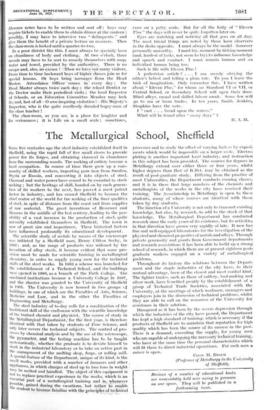The Metallurgical School, Sheffield
SOME five centuries ago the steel industry established itself in Sheffield, using the rapid fall of five small rivers to provide power for its forges, and obtaining charcoal in abundance from the surrounding woods. The making of cutlery became a local occupation. In course of time there grew up a com- munity of skilled workers, importing pure iron from Sweden, Styria or Russia, and converting it into objects of steel. Charcoal and water power have ceased to be essential to steel- making ; but the heritage ofskill, handed on by each genera- tion of its workers to the next, has proved a most potent factor in industry, and has caused Sheffield to become the chief centre of the world for the .making of the finer qualities of steel, in .spite- of distance from the coast and from supplies of raw material. The great inventions of Bessemer and Siemens in the middle of the last century, leading to the pos- sibility of a vast increase in the production of steel, quite naturally established themselves in Sheffield. The town is now of great size and importance. These historical factors have influenced profoundly its educational development.
The scientific study of. metals by means of the microscope was initiated by a Sheffield man, Henry Clifton Sorby, in 1863 ; and, as the iange of products was widened by the invention of alloy steels, it became evident that some pro- vision must be made for scientific training in metallurgical chemistry, in order to supply young men for the technical staffs of the steel works. In 1883 a scheme was launched for the establishment of a Technical School, and the buildings Were opened in 1886, as a branch of the Firth College. The combinedinstitutions became a University College in 1897, and the charter -was granted to the University of Sheffield in 1905. The University is now housed in two groups ce buildings, in one of which are the Faculties of Arts, Science, Medicine and Law, and in the other the Faculties of Engineering and Metallurgy. The steel industry of to-day calls for a combination of the traditional skill of the craftsman with the scientific kmowledge of the trained chemist and physicist. The course of study in the MetallurgicarDePaitiiierit,'fbr the firstYear, is therefore identical with that taken by students of Pure Science, and only later covers the technical subjects. The control of pro- cesses by chemical analysis and by the use of the microscope, the Pyrometer, and the testing machine has to be taught systematically, whether the graduate is to devOte himself to work in the industrial laboratory or to take an active part in the management of the melting shop, forge, or rolling mill. A special feature of the Department, unique of its kind, is the small works, provided with a number of furnaces and other appliances, in which charges of steel bp to two tons in weight • may he melted and handled. 'Theribject of this equipment is not to replace. practical experience in the works, which is an essential part -of a -metallurgical-training and whenever student gained -during the vacations, 'but rather to enable the student to become familiar with the principles of technical processes and to study the effect of varying factors by experi- ments which would be impossible on a larger scale. Electro- plating is another important local industry, and instruction in this subject has been provided. The courses for degrees in Metallurgy extend over either three or forir years, whilst higher degrees than that of B.Met. nay be obtained as the result of post-graduate study. Differing from the practice of most Universities, the Department conducts evening classes, and it is in these that large numbers of the chemists and metallurgists of the works in the city have received their training The Associateship in Metallurgy is open to thee students, many of whose courses are identical with those taken by day students. The function of a University is not only to transmit existing knowledge, but also, by research, to add to the stock of that krioWledge. The Metallurgical Department has conchicted research since the early years of its existence, but its activities in. that direction have grown very rapidly of late. It now has fine and well-equipped laboratories for the investigation of the physical and chemical properties of metals and alloys. Through. private generosity and grants from Government departments. and research associations it has been able to build up a strong school of research, in which there are at present eighteen post-' graduate workers engaged on a variety of metallurgical problems.
Throughout its history the relations between the Depart-: ment and the staple industries of the city have, to their mutual advantage, been of the closest and most cordial kind.: The lighter trades, such as those of cutlery, tool-making and silver work, have Inflated greatly by the establishment of a' group of Technical Trade Societies, associated with the University, at the meetings of which workmen, managers and employers join in the discussion of technical problems, whilst they are able to call on the resources of the University for assistance in their solution.
Hampered as it has been by the severe depression through which the industries of the city have passed, the Department
has kept a high standard of training, which is necessary if the products of Sheffield arc to maintain that reputation for high quality which has been the source of its success in the past... There is a demand, exceeding the supply, for young men. who are capable of undergoing the necessary technical training, • who have at the same time the personal characteristics which will fit them to direct industrial operations. For such men a career is open.
CECIL H. DESCII
(Professor of Metallurgy in the University of Sheffield).


























































 Previous page
Previous page